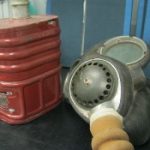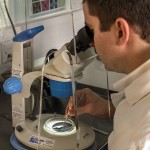A day in the life of a Bulk Analyst
Ever wondered how a sample is analysed?
Sarah Park, one of our Bulk Analysts, talks about her job and explains how asbestos samples are analysed and hopefully dispels some myths along the way too.
What do you like about being an Analyst?
It’s different to a normal 9-5 office job and quite demanding as you have to be alert at all times. Each day is different and there’s a great sense of satisfaction knowing that you’ve identified asbestos and prevented people from exposure.
Are there any down-sides?
It can be very tiring and hard on your eyes. The job requires a high degree of concentration and hence is quite mentally draining. It’s important to take regular breaks away from the microscope to help ease eye strain.
Describe a typical day
Firstly our fume cabinet is checked using an anometer to ensure it is operating at a face velocity of at least 0.5 metres per second. This makes sure air is drawn in through the aperture of the cabinet and then through a special filter called a HEPA filter. This filters out any asbestos fibres before re-circulating the air. Our Cargille Refractive Index liquids are then checked to ensure they are in date and free of contamination.
Next quality control checks are completed on each other’s work from the day before. This involves checking a percentage of each Analyst’s samples.
Workload is then prioritised.
How is a sample analysed?
Each sample is removed from its double sample bag and visually inspected within the cabinet using a low powered stereo microscope. This process will identify the product type and establish if fibres are present. If fibres are detected, the sample is prepared for fibre extraction. This can usually be done by mechanically extracting the fibres using fine tweezers and hand tools or by using chemicals to break down the component material for the next stage of analysis. The particular Cargille Refractive Index liquid, corresponding to the type of fibre suspected, is placed on the slide and the extracted fibres placed on the liquid. A cover slip is placed over the fibre/liquid mix and the slide removed from the fume cabinet. The sample is then placed under a Polarised Light Microscope (PLM) to determine the fibre type.
There are five stages in the PLM process to confirm the fibre type and whether it is asbestos with the morphology of the fibres and the way they interact with polarised light being assessed during these stages. Some other fibre types may mimic the physical properties of asbestos, yet when analysed under the PLM will not be identified as such.
Once the type of asbestos in the sample has been identified, the result of the analysis is input into our TEAMS asbestos management system and a Certificate of Analysis generated. Each Certificate is reviewed by one of our Technical Reviewers before being issued either as part of an asbestos survey report or as a standalone Certificate.
Strangest item analysed?
- WW2 gas mask

- 6ft door ( small sample removed for analysis)
- Bakelite hairdryer
- Radio
- Oven Glove
- Apron
- Radiator
How many types of asbestos are there?
There are six different types of asbestos fibres:
- Chrysotile

- Amosite
- Crocidolite
- Anthophyllite
- Tremolite
- Actinolite
How many samples can you analyse in a day?
As a UKAS Accredited Laboratory, each Analyst can analyse up to 70 points or 60 samples in a 24 hour period. Non-homogenous products such a textured coating and dust/debris count as 2 points per sample, so less of these can be analysed in a day.
What training is required?
Generally at least 3 months in-house training is undertaken prior to attending the BOHS P401 Course – Identification of Asbestos in Bulk Samples. On passing the exam analysts then need to prove they can analyse 20 Quality Control samples satisfactorily before being audited and signed off.
Not everyone is suited to be a Bulk Analyst and in-house training will help identify if someone is pre-disposed to the profession.
How often are you audited?
Various quality checks are undertaken on a daily, monthly and 4 monthly basis. Annual witness audits are also undertaken on microscope set up and samples analysis.
We also participate in the AIMS scheme as part of our UKAS accreditation, and have an annual external audit undertaken by a UKAS Technical Assessor.
Why do samples need to be double bagged?
A single bag could be contaminated on the outside from taking the sample and so it is double bagged to prevent contamination.
How long does a sample take to analyse?
Every sample is different but a single sample can be analysed and a certificate produced within the hour.